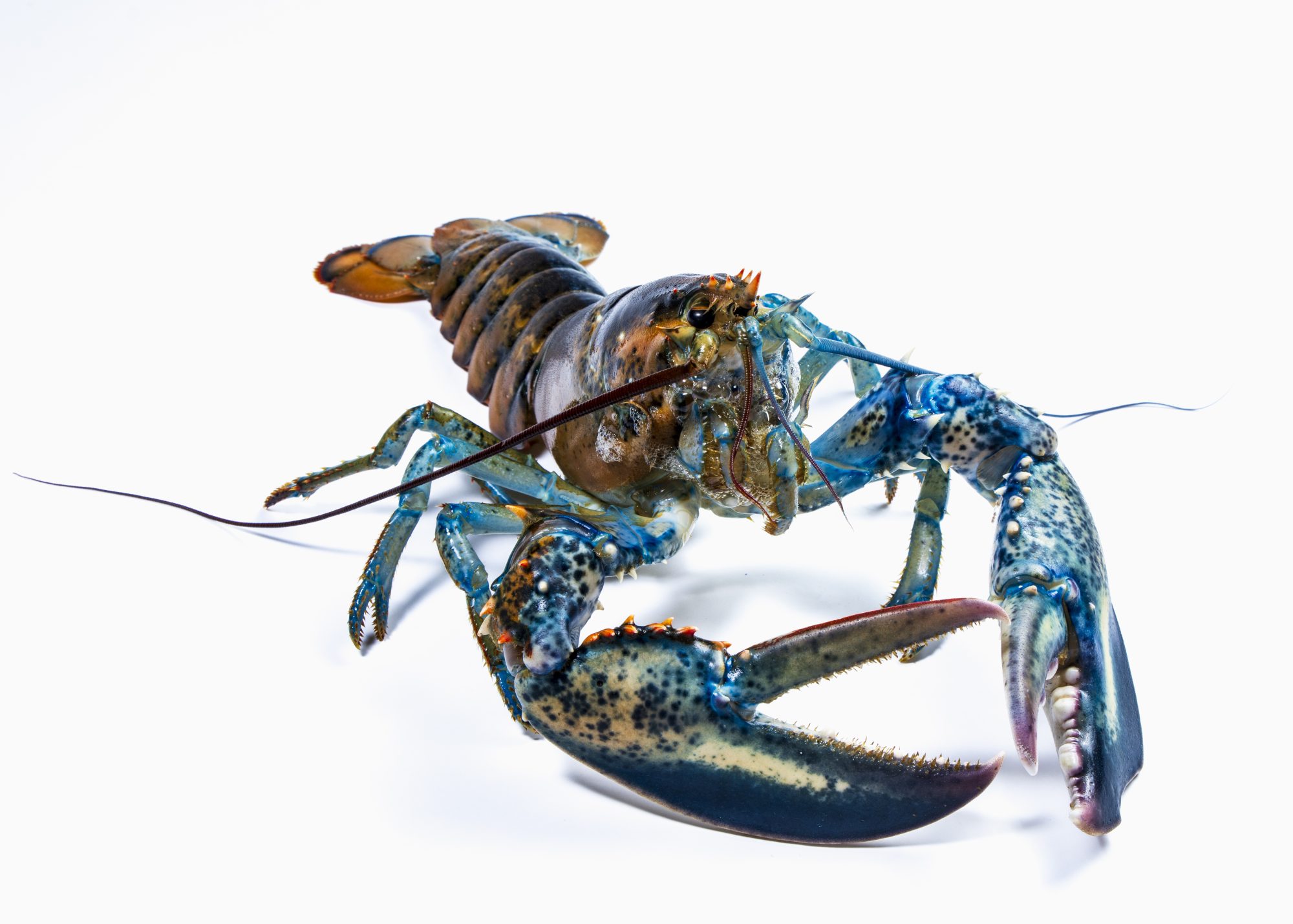In February of 2021, the University of New England welcomed its first celebrity crustacean: a yellow lobster named Banana. She'd been caught by local lobsterman Marley Babb, who realized that the crustacean was missing both of her largest claws. "He didn't want to put her back without claws, where she would be food quickly for other animals," said Markus Frederich, a marine biologist at the University of New England. So Babb drove two hours to drop Banana off at college in Biddeford, Maine where she still lives.
Around this time, Frederich, along with researchers at the Bigelow Laboratory for Ocean Sciences in Boothbay and Hood College in Maryland, had received a big grant from the National Science Foundation to study how climate change affects lobster larvae. The usually cool Gulf of Maine is warming faster than 99 percent of the ocean, which gave the New England institutions a front-row seat to this intense warming. Frederich and researchers raised and caught lobster larvae at different stages, exposed them to different temperatures, and sequenced their gene expression across the larval stages. They found a slew of genes that shape how the crustaceans develop and color their exoskeletons.
All the while, Banana and a few other rare colorful lobsters were sitting in tanks in the marine science center. The researchers had kept them around for education and outreach, but not for research. "We took them for granted," Frederich said. But the discovery of these new genes suggested an obvious project—looking into the molecular basis of rare lobster coloration, explaining why one in many million lobsters are not mottled brown but rather blue, yellow, speckled orange, or even translucent.
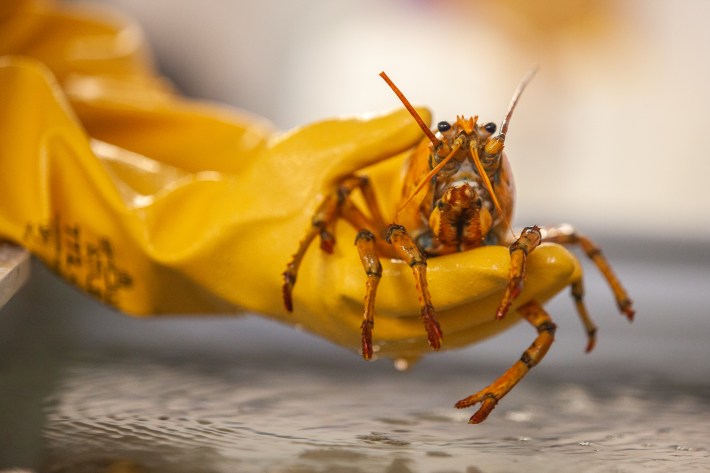
Before working on lobsters, Frederich studied green crabs, which change colors over the course of their lives. Although the freshly molted crabs are bright green, the crabs turn orange and red as they get older, only to switch back to bright green after their next molt. "It's the same animal, which goes through these color changes," Frederich said. "But in the lobsters it's very different, because a blue lobster is always blue. An orange lobster is always orange." While Frederich's research suggested the crabs' shell color was linked to stress tolerance, a lobster's shell color appeared to come from an entirely different mechanism.
Over the last decade, the marine science center has welcomed the occasional colored lobster into its tanks so students could marvel at the rarities. But after Frederich announced his plans to study the genetic basis of these colors, the collection kept growing. "Other lobstermen started contacting us," he said. "Saying 'hey, we just saw the news. You got this one? I found another one, do you want to have this one as well?'" The university now houses eight rare lobsters, Frederich estimated.
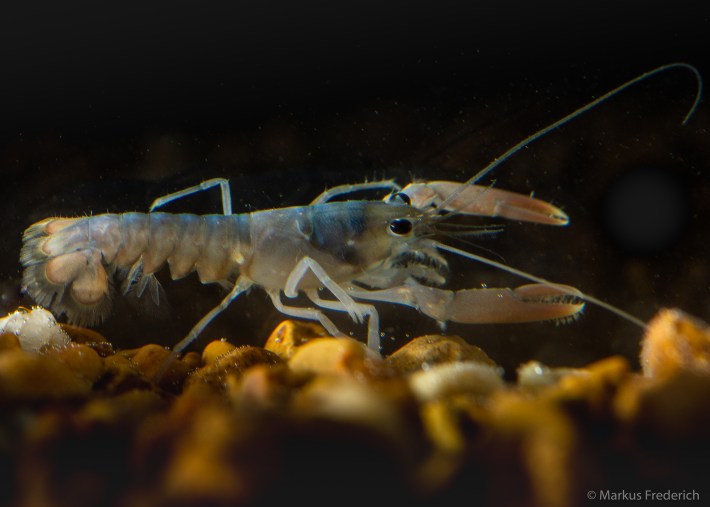
Lobsters spend their infancy nearly translucent and bobbing near the surface of the water. They only sink to the seafloor after their fourth molt. "One of our celebrities, Fig the purple lobster, actually started out as a bright blue larvae," Frederich said. Aubrey Jane, a graduate research assistant in Frederich's lab, caught Fig in the Gulf of Maine when the lobster as about an inch long. As Fig grew and molted over three years, she turned a dusky shade of purple.
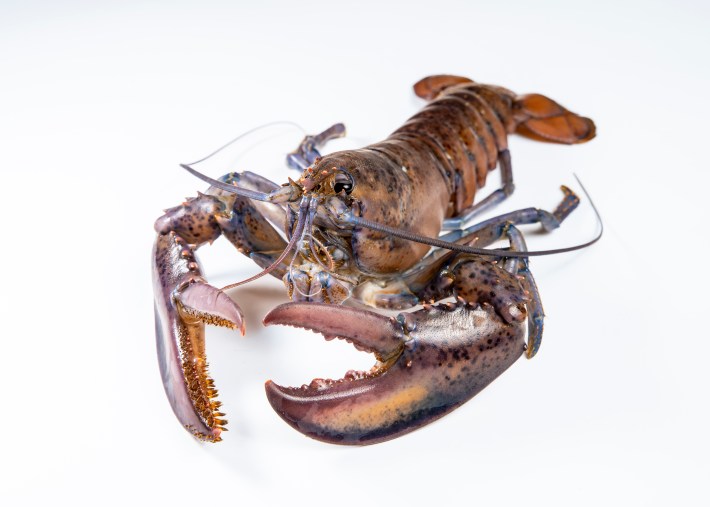
The center is also home to two rare split lobsters, Currant (seen in the very top photo) and Banana Split. Currant is a blue and brown split lobster, caught by Boothbay lobsterman Eben Wilson. Like all split lobsters, Currant was once two lobsters, which merged in early embryo development to become one. The other such lobster, Banana Split, is an orange and brown lobster. "I was in the car when I got the phone call that there is another split lobster in Portland if we want it," Frederich said. "I said yes and turned the car around and drove up to Portland." Frederich's eight-year-old son, who was in the car for this drive, was already a fan of Banana the yellow lobster and suggested the name.
Split lobsters often go viral, accompanied by the statistic that the odds of catching one are one in 50 million. Orange, yellow, and calico lobsters are all one in 30 million, blue lobsters are one in two million, and purple lobsters are one in a million. White or albino lobsters, which the university has yet to collect, are even rarer, reported at around one in 100 million. "I have no idea how accurate those numbers actually are," Frederich admits. "Everybody cites the same set of numbers." These statistics appear to come from rough estimates based on the many millions of lobsters that are caught each year. But they only include the rare lobsters that are reported. Maine lobster law dictates that lobsters must be within a range of legal size limits; if the crustacean is too large or too small, it must go back in the ocean.

Both Banana Split and Currant are male on both sides. But split lobsters can be male and female, and one such lobster, nicknamed Bowie, went viral in 2023 after they were caught by fifth-generation Maine lobsterman Jacob Knowles, who has three million followers on TikTok. "I follow his TikTok story about his lobstering, and I think he is brilliant in this outreach," Frederich said. Knowles made TikToks about his plans to keep Bowie in an aquarium to see if the two-sexed lobster could bear young. But when it became clear that Bowie was not doing well in captivity, Knowles notched their tail—ensuring the lobster will be returned to the sea if caught again—and released Bowie back into the ocean.
The university's calico lobster, Skittles, actually came from Knowles. He'd reached out to see if the university would want the black-and-orange lobster he'd just caught in Downeast Maine, and Frederich gave an enthusiastic yes. Knowles "actually hopped on his private float plane and was flying that lobster down to UNE and handed it over to us," Frederich said.
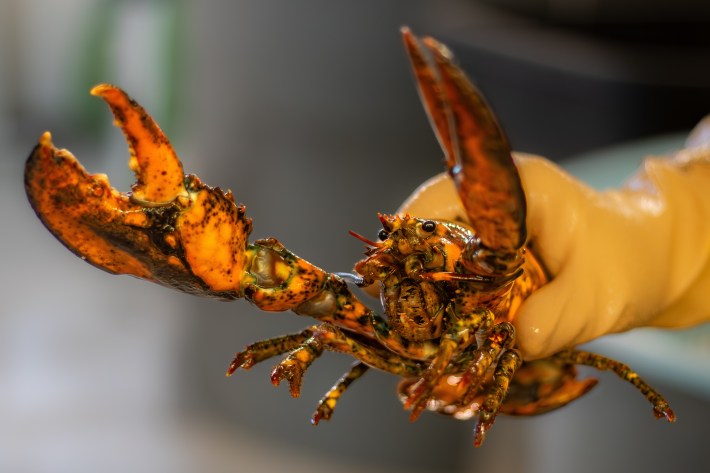
Currant, Bowie, and Banana Split are easy to spot because of the two different colors running along the length of their body. I asked Frederich if it was possible for two brown lobster embryos to merge into one, becoming a brown-brown split lobster—seemingly ordinary on the surface but carrying a secret underneath. "There is the suspicion that there are way more split lobsters out there," Frederich said. You would only be able to tell if the lobster was half-male, half-female, and it's likely that lobstermen (which is a gender-neutral term for those who lobster) would be the only ones looking. "I'm not aware of anyone reporting one of those animals, but they must be out there," Frederich added.
The buzziest celebrity lobster in Biddeford must be Peaches, a female orange lobster whose tail recently bloomed with eggs. "We're getting ready to capture all those larvae once she releases them, which we expect happens in May or June or so," Frederich said. He plans to raise those hundreds or thousands of larvae to see how many of Peaches' babies will be orange like her. The discovery of Peaches' eggs was exciting for the lab but also made the lobster's presence there immediately illegal under Maine lobster law, which prohibits anyone taking an egg-bearing lobster. So Frederich applied for a special permit that allows the university to keep Peaches specifically, as well as her hopefully orange offspring.

Frederich's lab is currently developing a non-invasive way to collect DNA from his eight rare lobsters. The researchers can already prick the lobsters to draw blood and isolate DNA, which is an easy and painless process for the lobsters. "But we also need some tissue right from underneath the outer shell," Frederich said. There, the researchers could harvest the cells that produce the outer shell and extract RNA to understand which genes are expressed. He wants to take as little tissue as possible, probably from one of the lobster's legs. Lobsters can regrow some limbs fairly quickly after several molts, he added.
Banana has molted three times since she first arrived at the center, living on a diet of clams, squid, and fish and in a tank of her own. She was the first lobster at the university to win the heart of a megafan, seven-year-old Uliana Cavalier, who wrote the lobster a Valentine's Day card and got to meet Banana in person in 2021. Frederich estimates that Banana, too, was seven years old upon their meeting. Now, Banana's claws are like new—"huge and scary and fully regrown," Frederich said.
